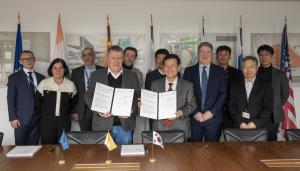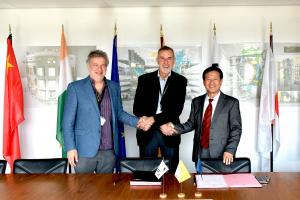Korea and Europe enter partnership
The future of fusion rests on the availably of two hydrogen isotopes, deuterium (one proton, one neutron) and tritium (one proton, two neutrons). Extracting deuterium from water is a relatively simple and proven industrial process, used mainly to produce the "heavy water" that acts as a coolant and neutron moderator in certain fission reactors. The only source of readily available tritium, a radioactive element which exists naturally only in trace amounts, is a type of fission reactor called CANDU where tritium is created by neutron capture in the heavy water coolant. Over the course of its scientific program, ITER will acquire and consume the totality of the world's tritium inventory, which amounts to only a few dozen kilos. Developing solutions to breed large quantities of tritium is therefore a precondition for the development of industrial and commercial fusion reactors.
Breeding tritium is an integral part of ITER, inscribed in the ITER Council-approved Project Specifications document: "ITER should test tritium breeding module concepts that would lead in a future reactor to tritium self-sufficiency, the extraction of high grade heat and electricity production." The project will experiment with tritium production within the vacuum vessel by way of test blanket modules (TBMs). The research activity runs in parallel to the ITER research plan and is considered "a project within the project."
Test blanket modules are based on a simple physics principle: when a neutron impacts a lithium nucleus, the reaction produces one atom of tritium. An intense flux of neutrons will be generated once ITER enters full power operation and the Earth's crust contains abundant reserves of lithium. The challenge the ITER Test Blanket Module Program is facing is to turn a physics principle into an efficient tritium-producing and extraction system.
Test blanket modules are the breeding elements of the tritium breeding blanket systems that are being designed independently by China, Europe, and Japan. In addition, Korea and Europe are collaborating to develop a joint test blanket module concept¹. This collaboration was formalized by the signature of the Test Blanket Module Partnership Agreement between the two Members at ITER Headquarters on 1 March 2023. A second document called a Test Blanket Module Arrangement—involving the ITER Organization as nuclear operator—was signed one week later.
These signatures marked the culmination of a multiyear process, and officially launched the start of design, construction and procurement activities by the fully integrated single-project Korean/European test blanket module team. Considering the sensitive and strategic nature of test blanket modules, and the considerable industrial and commercial implications of tritium breeding, the collaboration was hailed by all stakeholders as an exceptional example of trust, determination and team spirit.
¹ Four different test blanket module concepts are being developed by the ITER Members and will be integrated into two equatorial ports for testing on ITER: water-cooled lithium-lead (Europe); water-cooled ceramics breeder (Japan); helium-cooled ceramics breeder (China); and helium-cooled ceramic pebbles (Europe/Korea). All ITER Domestic Agencies are carrying out R&D on different aspects of the test blanket systems (i.e., coolant, materials, tritium extraction...). Learn more about the ITER Test Blanket Module Program in this recent ITER Talk.



